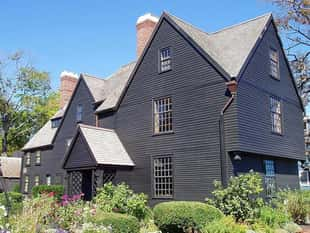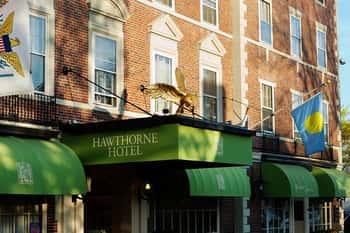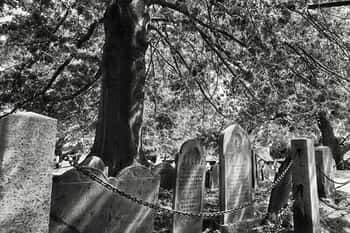Just fifteen miles north of Boston sits a four-hundred-year-old structure as foreboding as it is famous. The Witch House is thick with black timber, two-and-a-half stories tall. Located at 310 Essex Street in the McIntire Historic District of Salem, the house stands in testimony to the Witch Trials of 1692. The Witch House is the only surviving structure with direct ties to Salem’s Witch Trials — architecturally extraordinary, historically essential. Yet the haunts of the house extend past the hysteria. Purchased in 1675 by Judge Jonathan Corwin, magistrate of Salem’s Witch Trials, the Witch House remained with the Corwins until the mid-1800s. The “Corwin Curse” marked the house by 1718; eight Corwin lives were lost to premature death, catastrophically crippling the Corwin estate.
Rumor once held that the Witch House was used for the trial’s preliminary examinations, though this was later disproved. The Witch House itself harbored no witches, though Judge Jonathan Corwin did execute nineteen charged with witchcraft. Even the mason of the house was accused, and acquitted, of witchcraft. But is the Witch House, now a “Historic Home” of Essex County, haunted? If so, by whom?
The foundation of the Witch House was established between 1620 and 1642, yet was left unfinished until Jonathan Corwin’s purchase of the house in 1675. Corwin then had the partial construction remodeled by Daniel Andrews, improving the four-bedroom house with a six-foot, stone-walled cellar, underpinning, and steps. A building contract from February 19, 1675, reveals that the Witch House was likewise renovated to include five additional fireplaces on each floor of the two-and-a-half-story structure. Yet Daniel Andrews’ affiliation with the Witch House continues past his architecture. Later accused of witchcraft by Thomas and Nathaniel Putnam, Andrews was embroiled in the 1692 prosecutions. Andrews was, however, acquitted of witchcraft by the Reverend Cotton Mather, and was selected to replace the Putnam-Parris parties in the Salem committee. Corwin’s participation in Andrews’ acquittal is undocumented, though we may believe that Corwin persuaded the prosecution. Through Daniel Andrews, the Witch House was marked once more by the witch hunt.
From 1684 to 1690, the Witch House bore testimony to tragedy. Jonathan and Elizabeth Corwin had five new children; all died young. John, born 1684, died at nine weeks of age. Margaret Corwin, born 1685, died at six months of age. Anna Corwin, born 1687, lived longer than her siblings but suffered premature death at the age of nineteen. Two additional deaths would occur by 1690 with the loss of Jonathan Corwin Jr. by his third month and Herbert by his eighth week. Jonathan and Elizabeth Corwin continued to inhabit the home until 1717, yet were no longer the heads of household. The Witch House was instead overseen by their son, the Reverend George Corwin. His oversight was interrupted by his, too, untimely death: fever claimed the Reverend in November of 1717, then his wife, Mehitable, in 1718. This fever likewise claimed Jonathan and Elizabeth. George Jr. and Samuel, a pair of young boys, were all that were left of the Corwin legacy. Samuel recounted the curse in a later journal, naming death as “that unrelenting evening of mankind,” which had “made such havoc among [his] relations.” The Corwin estate collapsed; the Witch House remained.
The Davenports
Before Jonathan Corwin completed the Witch House, the Davenports laid the foundation. The Davenports were a prominent family in seventeenth-century Salem, with Richard Davenport first arriving on the Abigail in 1628. Richard’s marriage to Elizabeth Hathorne further defined the Davenports in Salem’s story, linking the Davenports to the much-publicized magistrate, John Hathorne. Hathorne would later act alongside Corwin in 1962 executions, attaching the Davenports to Corwin beyond Corwin’s purchase of the Witch House. Yet the Davenports are otherwise uninvolved in the witch trials. Richard Davenport became second-in-command to Captain Traske in 1637, and the “Keeper of the Castle” for Boston Harbor by the 1640s. Struck by lightning in 1665, Richard Davenport left the Davenport name to his son, Nathaniel. In 1975, Nathaniel fought, and died, at the Narragansett Indian Fort during the King’s Philip War. Jonathan Corwin purchased the Witch House from the Davenport estate the same year. But who, exactly, was Jonathan Corwin?
The Corwins
Although less known than “Hanging Judge” Hathorne, Jonathan Corwin supervised the pre-trial examinations for the Salem Witch Trials. Corwin was appointed to replace Judge Nathaniel Saltonstall for the Court of Oyer and Terminer, with Saltonstall resigning from the court after the execution of Bridget Bishop. Jonathan Corwin was an impressive replacement: Corwin had been twice elected to the colonial assembly a decade before. The Corwin surname added additional effect as Corwin’s father, George, had been a high-profile shipbuilder, merchant, and General Court representative. George even had a history of the witch hunt himself. In 1656, when Jonathan Corwin was sixteen, “Captain” George Corwin “discovered two Quaker aboard his ship, the Swallow, that had at the time been anchored in Boston Harbor. The two Quaker heretics had been arrested at once, inspected for marks indicating that they were witches, and then sent back to the ship to await deportation.”
Did George Corwin teach his son to fear the nonconformist? Did Jonathan Corwin follow in his father’s footsteps? The Corwin surname, however intolerant or suspicious, was nevertheless esteemed by Salem society. Corwin’s appointment to the Court of Oyer and Terminer was the obvious outcome in an otherwise unobvious ordeal. After having left a permanent imprint on both the Witch House and the “witch hunt,” Jonathan Corwin was buried in Broad Street Cemetery. His opinions on Salem’s Witch Trials are, to this day, unknown.
The Witch House underwent further renovation in the 1720s and 1760s as New Englanders adopted the English Georgian style. A gambrel roof was added by 1747, updating the seventeenth century Witch House to the fashions of the eighteenth century. The Witch House was again revitalized after America’s War of Independence, though the “Federal” architecture that was added, such as a Federal-style carriage and fence, no longer stands. By the nineteenth century, the Witch House included an Italianate-style drugstore and one-story addition. These additions were later removed by the Historic Salem, Inc., a preservation organization, and the Witch House was restored to its seventeenth century appearance.
Historic Salem likewise relocated the house thirty-five feet to the west, saving the Witch House from demolition. North Street, or State Route 114, was to be widened to accommodate traffic. The expansion of North Street would sacrifice the Witch House. Citizens collected $42,000 for the relocation of both the Witch House and neighboring Bowditch House, the former residence of the founder of modern maritime navigation.
Fortunately, historic Salem’s preservation project continued from 1944 to 1948, allowing Salem to refurbish the Witch House as a museum. By 1948, the Witch House was open to the public.
Olivia Bogart, whose father restored and relocated the home, later recalled the excavation of the property upon which the Witch House first stood. Bones were found, but the bodies of those poor souls who had perished were never identified.
Yet what, or who, haunts the Witch House? Those wrongly accused of witchcraft, or those caught by the “Corwin Curse”? Visitors to the Witch House claim to hear disembodied voices; some feel the chill of an unseen specter. Even Ghost Adventures investigated the Witch House during the nineteenth episode of their fourth season.
The Witch House holds more than the haunted, however. Inside a wall of the Witch House you will find a black shoe — a superstitious ritual to ward off witches. There are also “witch bottles,” a countermagical instrument containing urine, hair, pins, and fingernails. The witch bottle, like the black shoe, would protect the house from evil; unlike the black shoe, the witch bottle would capture evil before expelling evil. The urine was thought to attract a witch, and the pins were thought to catch and contain her. Perhaps they thought the best way to beat a witch was to join her in her game?
The Witch House also possesses a poppet, a doll used for spell-casting or “sympathetic” magic. The poppet, found in the nearby house of Bridget Bishop, may retain residual energy from Salem’s Witch Trials. How could it not? Bridget Bishop was the first executed.
Although the Witch House welcomed no witches, the Witch House bore witness to Salem’s Witch Trials. Its principal resident, Judge Jonathan Corwin, would oversee the execution of nineteen accused of witchcraft. Even The Witch House’s mason and remodeler, Daniel Andrews, would face accusations of witchcraft, though he would eventually be acquitted. One judge and twelve jurors later apologized for their part in the persecutions, but Jonathan Corwin stood silent.
The Witch House was marked by the witch hunt, permanently touched by his intolerance. The “Corwin Curse,” too, marks the Witch House. With eight Corwin lives lost to premature death, this “Historic Home” has testified to tragedy, terror, and tall tale. The Witch House was even uprooted and relocated, mystifying an already mysterious two-and-half-story home.
In total, over twenty innocent lives were lost to the prejudice of Judge Corwin and his peers. Five years later, on February 14, the General Court ordered that residents fast in atonement for their participation in Salem’s Witch Trials. The trials weren’t declared unlawful until 1702, however. Reparations were attempted by 1711, and a bill was passed to restore the names of those affected. The colony likewise granted £600 in restitution to their heirs. It wasn’t until 1957 that Massachusetts issued a formal apology for Salem’s Witch Trials.
The Witch House remains, first and foremost, a testament to those affected by Salem Witch Trials. While we cannot undo the crimes against them — neither their imprisonments nor their wrongful deaths — we can remember the injustices enacted upon them. This remembrance, with hope, may prevent us from repeating the 1692 “Witch Hysteria.”
Today Salem’s Witch House operates as a historic museum. Tours are offered to the public, allowing visitors to experience everyday life of seventeenth century Salem.
Visitors may find reproductions of Salem Witch Trial documents on display in the kitchen alongside seventeenth century cooking utensils. Visitors may also find a two-pronged fork belonging to John Proctor in the parlor, though the remaining artifacts of the museum are unrelated to the Witch Trials.
The Witch House, instead, provides a glimpse of seventeenth century architecture, fabric, and furniture.
Should you plan on visiting The Witch House in Historic Salem, Massachusetts, they offer self guided tours, along with private tour options. They are open from March - November, 10:00 AM - 5:00 PM. And if you do pay them a visit, let us know if you are one of the many who experience the energies of those who lost their lives at the notorious and infamous Salem Witch House.

One of Salem's most famous haunted houses

Spend a night in Salem's most haunted hotel

One of Salem's haunted Cemeteries